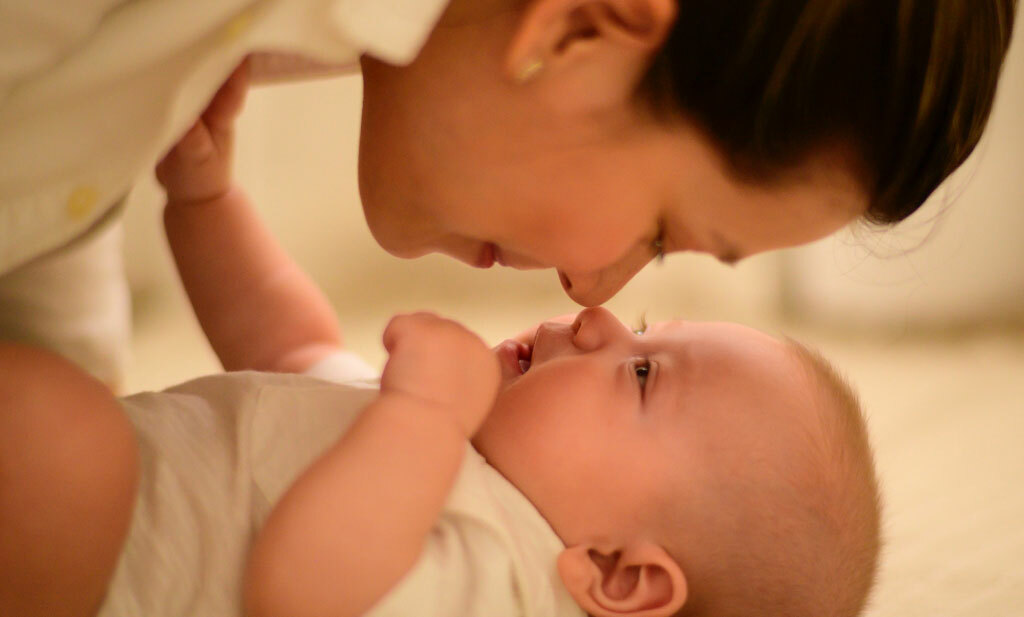
It’s no secret that babies need a lot of closeness and affection. Especially in the early months, when they have just arrived in the world. New parents know this all too well. So is your newborn baby crying when you lay them down? Whether it’s going to the toilet, a quick shower, preparing a bottle or porridge – as soon as you put the little one down in the playmat or baby bouncer, they get upset. But why is that? And what can you do? Our midwife and expert Katrin Ritter is here to help.
Baby cries when put down – why is that?
At Ergobaby, we always emphasise how important it is for your baby to be close to you. After all, newborns are used to the close confinement, warmth and sound of your heartbeat from the womb. Close physical contact is also extremely important so that the baby can build a secure bond with its caregivers. This is a basic need for your newborn baby. So it’s no wonder that your baby cries when you want to put them down. Carrying them gives them security and the secure bond ensures that they can develop in a socially and emotionally healthy way. That’s why we always recommend a baby carrier to ensure this closeness over a longer period of time in a way that is kind to your back and gives you two free hands to participate in life.
However, there are situations when you can’t or don’t want to carry your baby on your body. In our Evolve Baby Bouncer, baby is ergonomically and safely held for short periods in between using a baby carrier. However, you may be familiar with this if you have been using the baby bouncer since birth or have heard it from other parents: as soon as you take your child out of the carrier and want to put them down, they cry. This reaction from your little one may make you feel insecure, it’s hard to hear any crying baby, never mind your own! You may wonder whether a baby bouncer or playmat is the right place for your child to be put down. But don’t worry, this behaviour is completely normal and is down to a biological reflex.
Firstly, because it is safest for your baby to be very close to you and secondly, because your baby thinks that you are no longer there if it can no longer feel or see you. After all, the smaller it is, the more it cannot yet look far enough and sharply enough to see you from a distance. So if you are outside its radius of perception, even if it is only half a meter at first, it thinks it is all alone in this big wide world. And because that means danger in their little minds, it will report it directly and can cry as a result of this. In the early days, your child does not yet have the cognitive ability to understand that something they cannot see still exists – like their parents, for example.
Your baby can’t see you – the first stage of object permanence
The ability for baby to understand that you are still there, even if they cannot see you, is called object permanence. And this is still developing in the first two years of life. According to developmental psychologist Jean Piaget, sensorimotor intelligence develops in this early phase of life and is divided into six stages:
- 1st month of life: practicing innate reflex mechanisms. During this phase, babies learn how the body moves and how it functions. Their vision is blurred, and their attention span is very short. They are not aware that objects exist when they disappear from their field of vision.
- 1st – 4th month of life: Primary circular reaction (simple stimulus-response pattern). Babies perceive objects and follow their movements. If an object disappears, they continue to look where it was a moment ago – but only for a very short moment. They discover their eyes, arms, hands, and feet by looking at objects. In this phase, they react to familiar images and sounds and anticipate familiar processes, e.g. they open their mouths when a spoon approaches. Baby’s reactions are less reflexive and become more and more conscious.
- 4th-8th month of life: Secondary circular reaction (means to an end). Babies reach for objects that are partially hidden, showing that they know they still exist. However, if the object is completely hidden, the baby makes no effort to retrieve it. Movements are carried out more consciously, but the child mainly repeats similar actions on one and the same object. New behaviours are not yet imitated.
- 8-12 months: Coordination of acquired action patterns and their application to new situations (trial and error). This phase is the most important in a child’s cognitive development. At this point, the child understands causal relationships and acts in a goal-oriented manner. The first signs of object permanence become visible as the child can now retrieve objects when they are completely hidden. However, once the object has been found, it is still only thought to be in this place and not in another.
- 12-18 months: Tertiary circular reaction (there must be another way). The child now has a “means to an end” understanding and can solve new problems. They can now find an object several times if it is hidden in different places within his field of vision. However, not if it is outside of it.
- 8-24 months of age: Transition from the sensorimotor intelligence act to imagination (what if?) Object permanence is fully developed. A hidden object can now be found anywhere and exists for the child outside of its perception. If an object is hidden in a toy box and placed under a pillow and this object is then removed from the box – without the child noticing – and the toy box is handed over to the child, the child will search for the object under the pillow after realising that it is no longer in the box. The child is therefore able to develop a mental image, hold on to it mentally and then modify it so that it can solve a problem. The child is now able to deduce where an object could be located if it has been moved without their knowledge.
Newborn baby crying when they’re put down – what you can do
It is therefore completely normal for your baby to cry when you put them down because – as described in the first two stages of Piaget’s model – they simply think that they are all alone. In response, they cry. If you are now wondering what you can do to stop a crying baby, this is the wrong question to ask. Because your baby is not doing anything wrong, so they don’t need to be fixed. It is simply their way of communicating with you. So, your first task is to get to know and understand the different noises your child makes – including different types of crying. Listen very carefully and react promptly to the first and smallest noises your baby makes when you put them down. If you quickly fulfil the expressed need, then there will be none of that intense and desperate newborn baby crying. That’s why it’s so important that you always have your baby close to you in the first year of life – even if you only leave the room for a short time.

You can also playfully support your baby in developing object permanence skills. The game “peek-a-boo”, for example, is a popular variant. But other activities, books, and games in which something disappears and then suddenly reappears can also help your little one. In this way, your baby will gradually understand that something or someone that is gone for a short time usually comes back in the end.
Once object permanence is fully developed, you should think that it is no problem if a parent or caregiver leaves the room or the house. However, it can happen for a while that children suddenly develop separation anxiety. They now know that you still exist, even if you are not in the room. But that’s where the problem lies. Because you are no longer with them. And although they understand, they still need to put the connection together. But don’t worry, this state is just a phase, as they say. Over time, it will become easier and easier for them to separate from you – without any tears.



